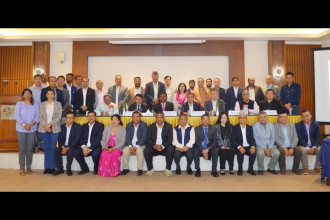-1740295159.jpg)
KATHMANDU: Dr Dina Shrestha, founder and President of the South Asian Obesity Forum, hosted the first International Obesity Congress in Nepal, on Saturday. With 17 presentations by representatives from Nepal, India, Bangladesh, Pakistan, Sri Lanka, Canada, Mauritius, and the United Arab Emirates, this event was the first collaborative effort among South Asian nations to combat obesity.
Dr Ashok Bhaseen, President of Thyroid Federation International, linked thyroid disorders with weight gain in his presentation titled 'Thyroid Advocacy: Learnings for Obesity'. Dr Bhaseen recommended testing within the first 24 hours of birth for the possible absence of the thyroid in newborns. Thyroid Federation International operates in 42 countries, including Nepal.
Dr Rucha J Mehta, Senior Consultant for Endocrinology and Diabetes in India, called for obesity to be categorised as a disease in her presentation titled 'Bariatric vs Medical Treatment for Obesity'. She found that while patients can lose up to 30% of their body fat through lifestyle interventions or invasive surgery, they often regain the weight within two years. Dr Mehta emphasised the importance of therapy both before and after the procedure for sustained weight loss.
Dr Faruque Pathan, President of the Bangladesh Endocrine Society, highlighted irregularities in diet, physical activity, mental state, and excessive screen time as factors contributing to obesity in his presentation titled 'Obesity: Impact in South East Asia'. He predicted that one in five men and one in seven women in South Asia may be obese.
Dr Payal Buckoreelall Chintaran, Secretary at the Endocrinology and Diabetes Association in Mauritius, found that 80% of Type 2 Diabetes patients are overweight or obese in her presentation titled 'Obesity: Impact on Diabetes Care'. These patients have higher rates of cardiovascular disease, chronic kidney disease, and diabetic foot.
Dr Musarrat Riaz, Professor at the National Institute of Diabetes and Endocrinology in Pakistan, discussed the interconnection between thyroid health and obesity in her presentation 'Obesity and the Thyroid'. However, she urged physicians to look beyond the thyroid when addressing patients' concerns.
-1740295211.jpeg)
-1740295210.jpeg)
-1740295210.jpeg)
-1740295208.jpeg)
-1740295209.jpeg)
-1740295212.jpeg)
-1740295214.jpeg)
-1740295214.jpeg)
Dr Nitin Kapoor, Head of Christian Medical College in India, spoke about the mental, mechanical, metabolic, and monetary factors affecting people with obesity today in his presentation titled 'Recent Advances in Obesity Management'. He noted that over a 10-year span, efforts by people with overt obesity to control their condition placed them in better conditions than those with normal weight obesity.
Dr Prasad Katulanda, Professor at the Royal College of Physicians in Sri Lanka, described the adverse effects of fat surrounding the liver for obese patients in his presentation titled 'The Obese Liver'.
Dr Helena Teede, Director of Monash Centre for Health Research Implementation in Australia, advocated for intervention in cases of excessive weight gain during pregnancy in her presentation titled 'PCOS & Obesity'. She argued that post-partum intervention is ineffective and late because the woman’s focus after birth is diverted from the condition of her body.
Dr Binit Vaidya, Head of Rheumatology at the National Center for Rheumatic Diseases in Nepal, described the dangers of leptin and oestrogen stored in fat in his presentation titled 'Obesity: Impact on Joints, Muscles, and Bones'. He attributed increased inflammation, disease flare, and cartilage degradation to excess leptin and recommended increasing muscle mass to support the bones and joints of patients with obesity.
Dr Faria Afsana, Associate Professor of Endocrinology in Bangladesh, detailed the genetic disadvantages passed to the offspring of obese women in her presentation titled 'Pregnancy Obesity: Foetal and Maternal Outcome'. She found that maternal obesity may confer obesity, neuropsychiatric disorders, asthma, and cancer to the offspring.
Dr Abha Shrestha, co-author of Dr Biraj Karmacharya’s 'Ho-DIRECT Nepal', presented a novel cost-effective diabetes remission approach in Nepal. Exclusive to Business 360, Dr Shrestha recommended reviving a high-fibre diet (buckwheat, brown rice) to induce satiety. This research was funded by the All Saints Educational Trust, England.
Ranil Jayawardena, Professor at the University of Colombo in Sri Lanka, recommended reducing rice intake for the South Asian population in his presentation titled 'Which Diet to Follow? Writing a Diet Prescription'. He suggested increasing protein and vegetable consumption while reducing carbohydrates.
Dr Shahjada Selim, General Secretary at the Bangladesh Endocrine Society, found that even a 5% decrease in body weight improves erection and sexual function in men in his presentation titled 'Obesity and Sexual Health'. Obese women, on the other hand, were found to have lower enjoyment of sex, avoid sexual activity, and lack arousal more than non-obese women.
Dr Sidhrah Lodhi, Assistant Professor of Endocrinology in Pakistan, and Dr Ashwin Pankajakshan, Consultant of Endocrinology in the UAE, shared the stage to present 'The Fat vs Fit Debate'.
In her presentation, 'Treating Heart Failure in Obesity,' Dr Jyoti Bhattarai, President of the Diabetes Endocrinology Association of Nepal, urged healthcare providers to shift from a glucose-centric approach to treating diabetes.
Dr Rucha J Mehta, Dr Sanjay Kalra, and Dr Sourabh Sharma of India utilised the platform to market medication to the audience of healthcare providers and pharmacists. The third edition of the Asian Journal of Obesity, edited by Dr Nitin Kapoor, was also released at this event.
Dr Hamid Ashraf of India led a panel discussion with Dr Yogesh Yadav, Dr Abhudya Verma, Dr Jaideep Khare, and Dr Lakshmi Nagendra of India on real-world scenarios, experiences, data, and the social stigma attached to obesity to conclude the event.




-1745481452.jpeg)

